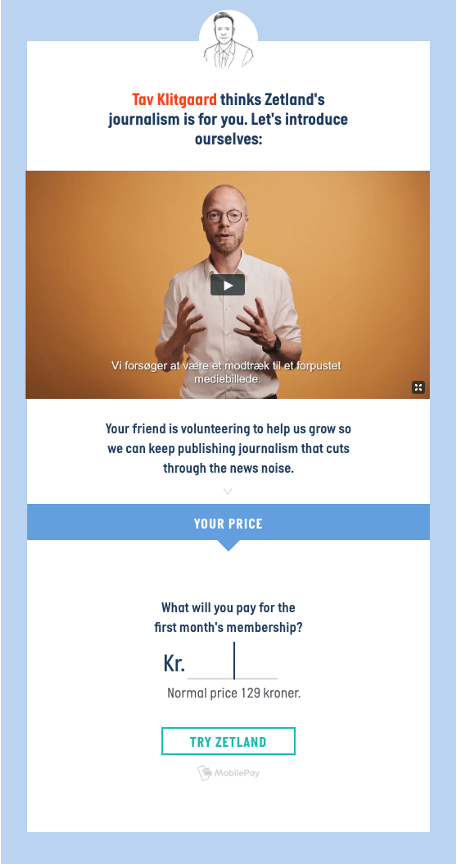Newsroom overview
A Danish member-driven newsroom that seeks to add complexity and curiosity to the news
Copenhagen, Denmark
2016
2016
17,000+
83 percent
In summer 2019, about three years after Zetland launched, the founders faced a hard truth. Despite many successes, they still weren’t profitable, and they were running out of time. Their monthly expenses totaled 1,650,000 krone (about $178,000), but monthly revenue only totaled 1,300,000 (about $140,000). CEO and co-founder Jakob Moll ran the numbers, and found that if they could grow their membership from 10,500 individuals to 14,000, they would break even.
With a clear goal in mind, they knew they needed to grow their membership, and quickly. Rather than turn to a typical marketing or acquisition campaign, they took a gamble: if they opened up about their financial situation and appealed to members’ passion for Zetland, could they enlist those members to help change their financial trajectory?
What followed was one of the most ambitious member-ambassador campaigns Membership Puzzle Project has seen. They surpassed their goal in less than a month, and at the end of 2019 they reached a major milestone: financial sustainability.
Why this is important
Marketing is an important component of your membership growth strategy, but many newsrooms focus on that and completely forget about one of the most powerful tools they have: their most loyal members. The Membership Puzzle Project sees membership as, among many things, a way to identify your strongest supporters and incorporate them in your quest for sustainability.
Few initiatives embody that more clearly than Zetland’s “members getting members” campaign.
The campaign wasn’t flashy. It didn’t include celebrities or any over-the-top swag. It succeeded because Zetland found the intersection point between their audience members’ passion for Zetland and their newsroom’s sustainability needs – and they were willing to offer complete transparency in exchange for members’ help. Understanding what motivates your audience members to participate and figuring out how that intersects with your needs is key.
What they did
In June 2019, co-founder and then CEO of Zetland Jakob Moll published a piece headlined: “Here are the key figures about Zetland’s business that are usually kept secret in a business like ours.” The article laid bare Zetland’s financial books.
Moll was blunt: “Right now, our expenses are greater than our income – in other words, the amount in our bank account is shrinking every month. If you spread out the snapshot over a whole year, we have an income of 1,300,000 a month and expenses of 1,650,000. If we had 14,000 paying members instead of 10,500, our expenses and income would balance.”
Moll’s financial tell-all article also introduced members to a proposed solution: become an ambassador for Zetland and recruit new members. In the ambassador campaign, newly recruited members got to pay whatever they wanted for the first month of access, but after that, they would have to pay the standard monthly membership fee of ~$14 a month. Here’s what this process looked like in practice:
They recruited “ambassadors” from their current member base. Ambassador recruitment officially started with Moll’s financial-tell-all article, which included a sign-up form for ambassadors that first verified the respondent was already a Zetland member. The sign-up form was also the process for onboarding ambassadors and included questions about how the ambassador preferred to recruit their new members. Over the next two weeks, more than 1,000 people across Denmark signed up to become ambassadors.
They equipped their new ambassadors for both digital and print recruitment campaigns. When a member became an ambassador, Zetland gave them a unique signup page URL that included their name. The URL brought potential new members to the pay-what-you-want sign-up form. Zetland also gave ambassadors the option of postcards or posters to spread the word offline. They shipped out more than 20,000 postcards and 2,000 posters with ambassadors’ personal codes for the ambassadors to share when the campaign launched.
They officially launched their ambassador campaign on Aug. 6, 2019. The ambassadors started recruiting new members by sharing a recruitment form with a video of Moll introducing himself and Zetland’s mission. Then, the reader was shown the dominant call-to-action, which was the pay-what-you want box.

When a new member signed up, Zetland sent them a long, personal welcome email from Lea Korsgaard, the editor-in-chief. They frequently reminded their readers, members and ambassadors that “this is your campaign, it’s not ours.”
Membership Puzzle Project shared additional details about the execution in its 2019 case study of the campaign.
The results
Zetland’s ambassador campaign launched on Aug. 6 and formally ended on Sept. 6. Their goal was to add 1,400 members to their then-10,500 members. They reached that goal in a week. In September, they passed 2,500 new members (totaling 13,000 members). By the end of the campaign, they surpassed 14,000 members.
That 14,000 number is significant because at 14,000 members, their newsroom broke even and started making a small profit. About six months after the campaign officially ended, Moll reported to Membership Puzzle that they are “moving toward 15,000 members.” So far 346 of those original ambassadors have signed up to be ambassadors year-round.
The pay-what-you-want model for the first month was also a success. New Zetland members didn’t go for the lowest possible payment. (On average, new Zetland members decided to pay a little bit less than the equivalent of $9, when the sticker price for the first month of membership is equivalent to $6.50.)
In addition to volunteering to help recruit new members, more than 500 Zetland members also volunteered to help with member-driven editorial projects in the coming months.
What they learned
Look to recruit people who are willing to pay some amount for membership. Zetland ran its first ambassador campaign in 2018. It brought in 700 new members, but many of those members didn’t stick. Only half of them even logged on to Zetland after the campaign ended. Moll believes that giving free access sent the wrong message to their audiences. In 2019, Zetland focused on recruiting members who understood the value of high-quality journalism — the folks who were willing to pay for it — and it worked. The members recruited during their 2019 campaign have a retention rate that mirrors that of Zetland’s overall membership.
Be honest about your financial situation and what you need from your members. Zetland found their ambassadors eager to jump in and help the newsroom reach financial sustainability. The radically honest articles published prior to the ambassador campaign’s launch (including how many more members, exactly, they needed to survive) helped mobilize their current members into action.
Set up your ambassadors for success, and say thank you often. The Zetland team worked hard to make their ambassadors feel special, empowering them to recruit new members either digitally with their personalized URLs or manually with postcards. Ambassadors also received small gifts like stickers and packets of plant seeds. The Zetland team was sure to say thank you often, and to keep their ambassadors updated on the newsroom’s progress and success along the way.
Key takeaways and cautionary notes
Find ways to harness members’ passion for your organization. Ambassadorship taps into members’ passion for your work – one of the six key motivations MPP heard when analyzing responses from hundreds of supporters of news organizations about why they gave their support. Members motivated by the chance to show some love for your mission are proud of their affinity with your organization and want people to know about it.
Although only a small percentage of your members will likely respond to your call for ambassadors (the 90/10/1 rule is that 90 percent of members will just consume the product, 10 percent will interact with you, and 1 percent of that 10 percent will become core contributors), that small percentage can have a transformative impact.
Other resources
- Membership Puzzle Project, research: How “members getting members” brought Zetland to sustainability
- Membership Puzzle Project, research: Why your community members want to aid your reporting & 25 jobs you can ask them to do


